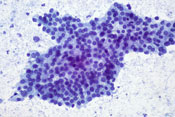Featured Article
Chemotherapy Regimen Extends Survival in Advanced Pancreatic Cancer Patients
 Pathology slide showing the most common type of pancreatic cancer, an adenocarcinoma. Less than 5 percent of patients diagnosed with the disease live more than 5 years. (Photo by Ed Uthman)
Pathology slide showing the most common type of pancreatic cancer, an adenocarcinoma. Less than 5 percent of patients diagnosed with the disease live more than 5 years. (Photo by Ed Uthman)A four-drug chemotherapy regimen has produced the longest improvement in survival ever seen in a phase III clinical trial of patients with metastatic pancreatic cancer, one of the deadliest types of cancer. Patients who received the regimen, called FOLFIRINOX, lived approximately 4 months longer than patients treated with the current standard of care, gemcitabine (11.1 months compared with 6.8 months).
Results from the trial, which was conducted at 48 hospitals in France, were published in the May 12 New England Journal of Medicine.
The regimen includes the drugs fluorouracil (also known as 5-FU), leucovorin, irinotecan, and oxaliplatin. Because of serious side effects, the treatment is not suitable for all patients with metastatic disease, several pancreatic cancer researchers cautioned. But for patients who are candidates, based on having what is called a good performance status, the regimen will likely become the standard of care, the researchers noted.
"Clearly these are the best results we've seen to date for advanced pancreatic cancer patients in terms of response rate and overall outcome," said Dr. Al Benson of the Robert H. Lurie Comprehensive Cancer Center of Northwestern University, who was not involved with the study. "But this is a potentially very toxic combination," he continued, "so there has to be a note of caution when considering patients for this regimen."
Results from the trial were somewhat unexpected. Over the last few decades, numerous chemotherapy drugs have been tested alone and in various combinations in patients with pancreatic cancer, almost always with little or no impact on disease progression or survival.
Clinicians and patients still have to weigh the risks versus the benefits of treatment, stressed Dr. Jack Welch of NCI's Division of Cancer Treatment and Diagnosis. "But the benefit of the FOLFIRINOX regimen is really hard to overstate in terms of what's been accomplished in pancreatic cancer to date."
Trial Design and Patient Selection
—Dr. Jack Welch
The French clinical trial employed an efficient design, Dr. Welch noted. The study eventually enrolled 342 patients but began as a more modest randomized phase II trial. Based on tumor responses seen in the first 88 patients, the French research team expanded the study and was able to include the participants from the phase II trial in the phase III trial population.
All patients in the trial had a performance status of 0 or 1, based on a commonly used scale of 0 to 5. Approximately 20 to 25 percent of patients with metastatic pancreatic cancer likely fall into this category and would be candidates to receive FOLFIRINOX, explained Dr. Philip A. Philip of the Barbara Ann Karmanos Cancer Institute in Detroit.
In addition to the improvement in overall survival, nearly one-third of patients in the FOLFIRINOX arm of the trial had some tumor shrinkage, compared with only 9 percent of patients in the gemcitabine arm.
Based on the presentation of the trial's initial survival results last year at the American Society of Clinical Oncology annual meeting, "community oncologists are increasingly adopting this regimen in day-to-day practice," Dr. Philip said.
The serious side effects associated with the FOLFIRINOX regimen include neutropenia, neuropathy, and gastrointestinal problems. And yet, more patients in the gemcitabine arm dropped out of the study because of side effects, noted the study's lead investigator, Dr. Thierry Conroy of the Centre Alexis Vautrin and Nancy University, in an e-mail.
In addition to performance status, patient age (those younger than 76) and liver function determine which patients are candidates for the regimen, Dr. Conroy explained.
Because of the high risk of neutropenia associated with the FOLFIRINOX regimen, Dr. Benson added, oncologists need to proceed with caution before using it in patients who have a biliary stent. Biliary stents are common in patients with pancreatic cancer, he said, because tumors that form in the head of the pancreas can often obstruct the bile duct, preventing it from feeding properly into the small intestine; a stent is used to alleviate the obstruction.
Neutropenia, Dr. Benson continued, puts patients with biliary stents at increased risk for infections that can lead to sepsis, a potentially fatal blood infection.
Looking for Less-Toxic Combinations
Although the trial results are welcome news, there is still a tremendous amount of work to be done in this disease, Dr. Philip stressed. "New drug development must not ignore the patients with lesser performance status who cannot tolerate this regimen," he said.
Researchers are now looking to build on the success of the FOLFIRINOX regimen. For example, Dr. Conroy and his colleagues are planning to test it as a post-surgical, or adjuvant, therapy in the small proportion of patients who are diagnosed with earlier-stage disease and who are candidates to have their tumors surgically removed.
FOLFIRNOX's efficacy opens up new avenues of investigation, stressed Dr. Welch, including using it as a backbone on which to piggy back other treatments, particularly targeted therapies that don't have overlapping toxicities. The regimen also needs to be "dissected" and optimized to determine if all four drugs are required or if dosages can be adjusted so that the efficacy can be maintained while alleviating or mitigating some of the regimen's serious side effects.
"For many years all we had as a chemotherapy backbone was gemcitabine," Dr. Welch said. "Now we can be much more flexible in our thinking."


